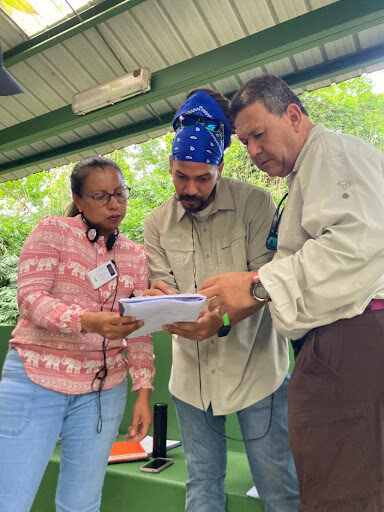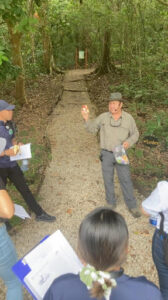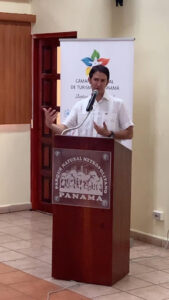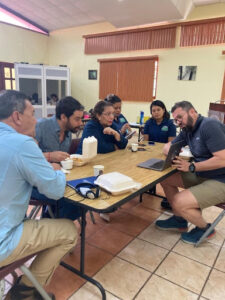News & Updates
Leave No Trace Develops Training Strategy with Panamá Ministry of Tourism


PANAMÁ CITY, PANAMÁ — Parque Natural Metropolitano sits on a hill north of downtown Panamá City. This 230-hectare park protects vast expanses of tropical semi-deciduous forest within the city limits, and serves as an incredible wilderness escape from the busy capital.

In January, 12 staff members representing parks and tourism professionals from across Panamá, met with Leave No Trace to discuss Panamá’s vision for responsible visitation and its recreation future. With the help of in-person translators, Leave No Trace Education Department leaders JD Tanner and Andrew Leary taught the Master Educator course in Spanish.
At the trailhead of Sendero Los Caobos, Abdiel Iván Batista, an instructor and naturalist from the Fundacion AviFauna (Panama Rainforest Discovery Center), provided a lesson on the importance of respecting wildlife, including the Terciopelo (Fer-de-lance pit viper). Iván’s storytelling, aided by a well-timed prop rubber snake, brought his commitment to education and conservation to life.
The commitment to Leave No Trace education goes beyond Parque Natural Metropolitano. Decision makers at the highest levels of Panama’s government have taken note of the new educational initiative. “We are committed to developing our adventure travel industry with a strong visitor ethics component, so training instructors with Leave No Trace’s principles are a very relevant step for us in that direction,” said Iván Eskildsen, Panama’s Minister of Tourism, in a recent Linked post reflecting on the Leave No Trace course made possible by his office, Autoridad de Turismo Panamá (the Ministry of Tourism).
Panamá is embarking on a visitor economy strategy that leverages its parks, natural areas and emerging network of cross-country trails. This is a familiar story to many destination professionals in the United States who for years have leveraged parks and protected areas to attract visitors. For decades, tourism professionals in the U.S. used to invite people to experience the beauty and grandeur of National Parks and protected Wilderness-areas while leaving the conservation education duties to resource-strapped land managers.
But now—in part fueled by the effects of the COVID-19 pandemic and people’s desires to spend time outdoors—destination professionals are deploying strategies to reach visitors with responsible recreation education based on Leave No Trace during the trip planning phase.
“We made a breakthrough with these education strategies when tourism organizations at state and county levels began to incorporate effective Leave No Trace education into their marketing efforts,” says Andrew Leary, Director of Sustainable Tourism and Partnerships at Leave No Trace. “What we’ve seen as a result is improved natural resource conditions in parks, more informed visitors, and improved relationships between tourism and community stakeholders that has traditionally been a source of friction.”
Where Panamá differs compared to the U.S. approach, however, is where the most opportunity lies: building Leave No Trace education into a tourism-driven recreation visitor economy from the ground-up.
“Having Leave No Trace in Panama helps us create an outdoor ethic in this country,” says Adrian Benedetti, coordinator of the 1,000 Kilometer Trails Project. “Now that the Panamanian government is investing through the trails project and considering this sector strategically, we can also accompany the promoting of outdoor recreation and visitation to parks and protected areas with introducing and education and ethics program that can help guides; that can help places that have environmental education programs; that can help government institutions that are engaged in this issue to see clearly how we can promote visitation in a more sustainable manner and help prepare visitors for safer and more sustainable experiences.”
 The 1,000 Kilometer Trails Project aims to conserve nature and diversify rural economies through the development of the outdoor recreation industry and green tourism in protected areas. It is also aligned with the national government’s Colmena Plan, which has among its objectives that marginalized rural communities benefit from economic activities.
The 1,000 Kilometer Trails Project aims to conserve nature and diversify rural economies through the development of the outdoor recreation industry and green tourism in protected areas. It is also aligned with the national government’s Colmena Plan, which has among its objectives that marginalized rural communities benefit from economic activities.
“Leading a Spanish-language Leave No Trace course provided an amazing chance to examine responsible visitation and Leave No Trace through the Panamanian culture, where the idea of “wilderness” does not have a direct translation,” said Leary. “Throughout the entire week, my colleagues at Autoridad de Turismo Panamá (the Ministry of Tourism), Ministerio de Ambiente (the Ministry of the Environment), Fundacion AviFauna (Panama Rainforest Discovery Center), Parque Natural Metropolitano and Parque Municipal Summit showed great care and forward thinking for how the Leave No Trace may provide five new approaches to implement a country-wide education platform that begins with Panamanians, the visitor economy and then visitors themselves,” says Leary.
Where Panama takes its new strategies will certainly be shaped by the upcoming government elections in May. For the time being, however, 12 newly certified Leave No Trace Master Educators and their supporters at the ministry level will offer as many as 24 Leave No Trace education courses to fellow Panamanians over the next 12 months. Benedetti also sees a Panama Leave No Trace alliance on the horizon. “Why reinvent the wheel when we have these Seven Principles that are fairly universal to the outdoor recreation experience? There may be some nuances — that’s what we’ll get into developing so that we can support the Panamanian version of the outdoor recreation experience.”
Let’s protect and enjoy our natural world together
Get the latest in Leave No Trace eNews in your inbox so you can stay informed and involved.
